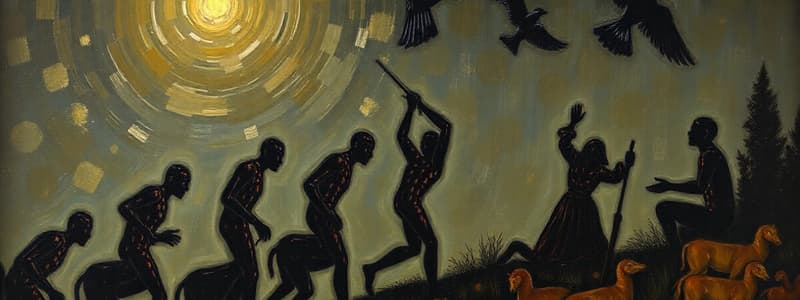Podcast
Questions and Answers
What does evolution refer to?
What does evolution refer to?
descent with inherited modification
Which of the following are considered evolutionary forces?
Which of the following are considered evolutionary forces?
- Mutation (correct)
- Selection (correct)
- Migration (correct)
- Genetic Drift (correct)
What is a key observation that supports Darwin's theory of natural selection?
What is a key observation that supports Darwin's theory of natural selection?
Variation and heritability
What is the inference that indicates some individuals are more likely to reproduce?
What is the inference that indicates some individuals are more likely to reproduce?
What is the outcome of having more offspring than the environment can support?
What is the outcome of having more offspring than the environment can support?
Natural selection is one mechanism by which _____ occurs.
Natural selection is one mechanism by which _____ occurs.
What is an adaptation?
What is an adaptation?
Flashcards are hidden until you start studying
Study Notes
Introduction to Evolution
- Evolution is descent with inherited modification
- Evolution includes microevolution and macroevolution
- Microevolution is change in gene frequency over time.
- Macroevolution is speciation.
Evolutionary Forces
- The four evolutionary forces are mutation, migration, selection, and genetic drift.
- Selection is influenced by natural selection and sexual selection
Darwin's Theory of Natural Selection
- Darwin's theory states that variations within a species can be passed down from a parent to its offspring.
- Evidence for this comes from selective breeding or artificial selection.
- Examples of artificial selection include pigeon fanciers breeding pigeons and selective breeding in agriculture.
- Darwin's other key observation is that all species produce more offspring than the environment can support but populations remain stable.
The Basis of Natural Selection
- The basis of natural selection is variation, heritability and overproduction.
- Variations within a population are heritable.
- Individuals that possess heritable traits that allow them to better survive are more likely to reproduce.
- This results in a change in the frequency of traits within a population over time.
Evolution by Natural Selection
- Darwin explained evolution as "descent with modification" from a common ancestor.
- Dobzhansky later defined evolution as the change in the allele frequency in a gene pool.
- Natural selection is one mechanism by which evolution occurs.
Adaptation
- An adaptation is the process of species becoming better suited to their environment over time.
- An adaptive trait is a trait with a function that helps individuals survive.
- Adaptations occur in populations over generations, not individuals.
Studying That Suits You
Use AI to generate personalized quizzes and flashcards to suit your learning preferences.




